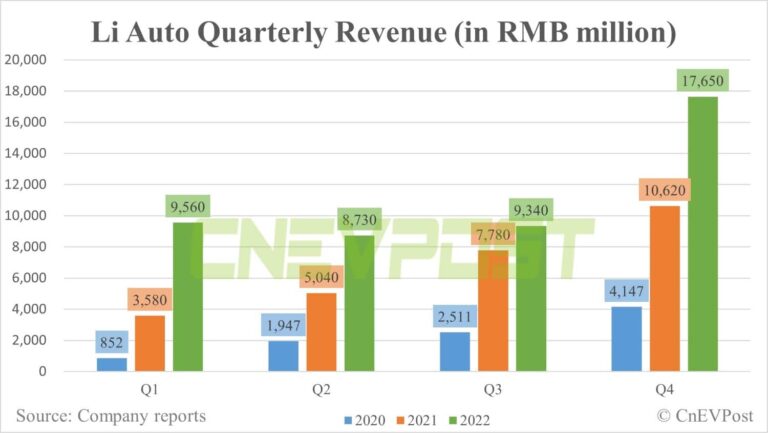Li Auto has an internal goal of 25,000-30,000 monthly deliveries and will aim to achieve that goal in the second quarter.
(Image credit: Li Auto)
Li Auto (NASDAQ: LI) reported relatively solid fourth-quarter earnings on Monday and held an analyst call afterward.
Here are the key takeaways from the company's earnings call, as compiled by CnEVPost.
Li Auto has an internal goal of 25,000-30,000 monthly deliveries and will aim to achieve that goal in the second quarter.
April will be the first full delivery month for the Li L7 Pro and Li L7 Max, and May will be the first full delivery month for the Air product line.
Li Auto had some issues with capacity creep in the second half of last year, including an aggressive delivery schedule that put a lot of pressure on the supply chain.
The company's product matrix went from a single model to multiple models in the second half of last year, creating significant challenges for the sales and service network system.
Li Auto began workflow upgrades in the fourth quarter of last year and the first quarter of this year to enhance product development, sales and service, supply and manufacturing capabilities to achieve high-quality deliveries.
The company said it is good news if the price of batteries can be brought back to the rational range and improve the competitiveness of the new energy vehicle (NEV) market as well as its market share, regardless of the discount of lithium ore or the linkage of battery prices with raw materials.
Li Auto said that the power battery is an important part of NEVs, and the diversified supply strategy of battery suppliers is to meet the supply security and development progress.
In response to rumors of a new pricing arrangement with CATL, Li Auto said negotiations are still underway.
Lithium carbonate prices dropped to RMB 400,000 per ton in the past few days, and a drop in battery prices is inevitable, its management said.
Li Auto believes the gross margin of about 20 percent in the fourth quarter was healthy and in line with the company's plan.
The bulk of the company's sales have come from the Li L9 and Li L8 since the fourth quarter of last year, and both models are in a capacity creep.
There will be a lag in cost reductions in the supply chain, which will improve in the next quarter, and the overall gross margin level for the L series will be around 25 percent.
For future all-electric models, infrastructure is critical and users need a charging experience close to that of a fuel car.
Li Auto will use 800 V technology and has built its own silicon carbide module factory.
Current real-world measurements show that Li Auto's new product can save about 15 percent of battery capacity compared to mainstream 400 V, IGBT module products, resulting in significant cost reductions.
The new model, Li L7, will be able to deliver a few thousand units per month initially and will continue to climb thereafter.
Considering the market conditions this year, Li Auto is maintaining margin guidance of over 20 percent.
Li Auto's orders in Shanghai were relatively poor in January, which was mainly due to sales being released early in November and December. (Note: Shanghai no longer offers free NEV licenses for PHEV models starting in 2023; BEV models continue to be eligible.)
Demand for Li Auto models in Shanghai started to recover in February, and the company's share in Shanghai is expected to be comparable to that of Beijing.
If a product is delayed, it will be mainly to carry state-of-the-art technology, such as the Qualcomm 8295 chip at the end of 2023, an important upgrade.
For pure electric models, Li Auto will launch products similar to the L series to meet demand in the RMB 200,000 ($2,8800) - 500,000 price range.
Li Auto's share of the SUV market in the RMB 300,000-500,000 price range was 9.5 percent in 2022. The company forecasts sales of 1.4-1.5 million units in this market this year and is targeting a 20 percent share in this market this year.
For the market in the RMB 200,000-300,000 price range, Li Auto believes it needs to enter after it has a stronger scale effect.
Li Auto has invested a lot of time in AI-based cognitive technology development, especially the combination of AI and gesture recognition. This is very important in the smart space and can provide a better experience for consumers.
The company is looking closely at ChatGPT and believes that the technology behind it, including the large language model and training model, is very similar to what Li Auto is doing in the cockpit space and that autonomous driving and subsequent R&D will benefit from it.
The number of consumers with overlapping demand for the Li L7 and Li L8 is not as large as expected, and the level of interest in the Li L7 is driving the growth in orders for the Li L8.
The Li L7, Li L8 and Li L9 cover the lineup that Li Auto wants to build in hopes that any consumer with family SUV needs will be catered to.
($1 = 6.9450 RMB)


